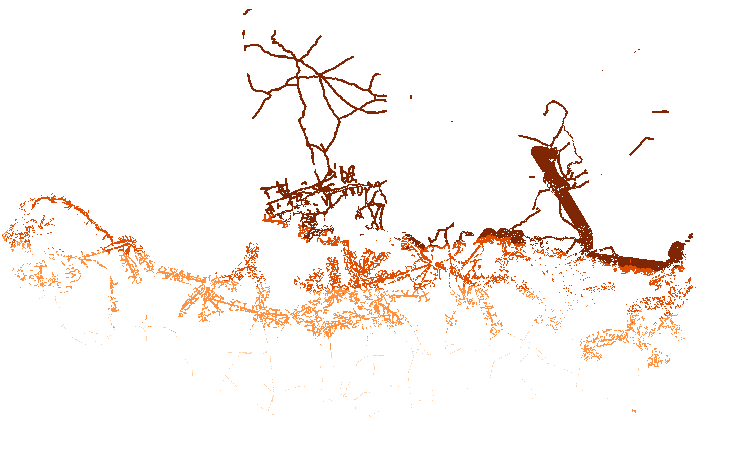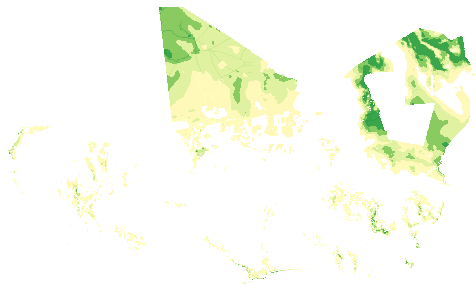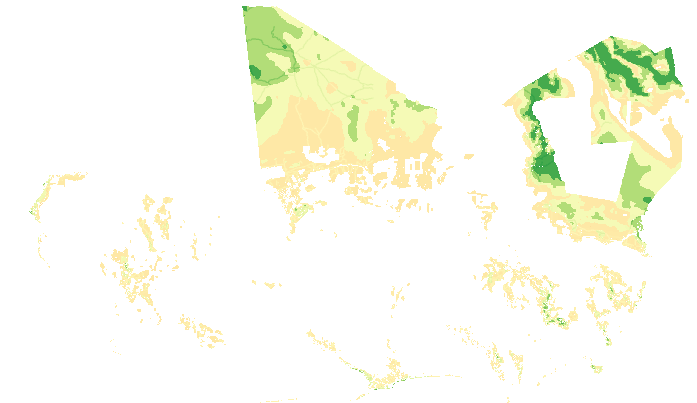OGC:OWS-C
Keywords
Contact for the resource
Provided by
Years
Formats
Representation types
Update frequencies
status
Scale
-
The Africa land cover map is a regional component of the GLC2000 exercise, conceived and coordinated by the European Commission’s Joint Research Centre. From the Africa land cover map, which is a regional component of the GLC2000 exercise, conceived and coordinated by the European Commission’s Joint Research Centre. The GLC2000 maps are based on daily observations made from 1st November 1999 to 31st December 2000 by the VEGETATION sensor on the SPOT 4 satellite. Legend- definition of the Gray index value: -11: post-flooding or irrigated croplands -14: rainfed croplands -20: mosaic cropland (50-70%) / Vegetation (grassland, shrubland, forest) (20-50%) -30: mosaic vegetation (grassland, shrubland, forest) (50-70%) / cropland (20-50%) -40: closed to open (>15%) broadleaved evergreen and/or semi-deciduous forest (>5m) -50: closed (>40%) broadleaved deciduous forest (>5m) -60: open (15-40%) broadleaved deciduous forest (>5m) -70: closed (>40%) needleleaved evergreen forest (5m) -90: open (15-40%) needleleaved deciduous or evergreen forest (5m) -100: closed to open (>15%) mixed broadleaved and needleleaved forest (>5m) -110: mosaic forest / shrubland (50-70%) / grassland (20-50%) -120: mosaic grassland (50-70%) / forest/shrubland (20-50%) -130: closed to open (>15%) shrubland (<5m) -140: closed to open (>15%) grassland -150: sparse (>15%) vegetation (woody vegetation, shrubs, grassland) -160: closed (>40) broadleaved forest regularly flooded- fresh water -170: closed (>40%) broadleaved semi-deciduous and/or evergreen forest regularly flooded- saline water -180: closed to open (>15%) vegetation (grassland, shrubland, woody vegetation) on regularly flooded or waterlogged soil- fresh, brackish or saline water -190: artificial surfaces and associated areas (urban areas >50%) -200: bare areas -210: water bodies -220: permanent snow and ice
-

This dataset was generated using GIS methods to estimate technical potential for solar electricity generation in rural areas of ECOWAS region. Technical potential of solar generation in a chosen area may be defined as the amount of the total yearly solar radiation available in that area, taking into account existing geographical constraints, ("suitability maps") that can be converted into electricity given the available solar power technologies. Technical potentials in GWh per year per cell at 1km resolution have been calculated by multiplying DNI (or GHI) for the technical parameters (performance, efficiency) related to CSP or PV, and for the available area. The available area was estimated using for: - CSP (grid connected) only cells with land suitability score > 302 (5% of total cells) - PV (grid connected) only cells with land suitability score > 299 (5% of total cells) - PV (off grid) only cells with land suitability score > 255 (5% of total cells)
-
The layer provides quantitative information about the inhabitants main points in the different countries for the ECOWAS region
-

The suitability maps, contain information on locations suitable for installation of the respective wind electricity generation systems in accordance with the restrictive criteria adopted. Locations are evaluated according to their suitability for onshore wind systems deployment according to topographical, legal, and social constraints, and well as factors that could facilitate or impede wind generation development. The present study focus exclusively on land suitability for the installation of onshore wind turbine and wind farm. The study is conducted on a regional scale. The results can be used for identification of potential areas of interest for solar generation deployment, and as a support for integration between electricity grid expansion and off-grid electrification policies. Off-grid installations - ecological scenario: Installation NOT connected to the electrical grid, environmental impacts minimized
-

The suitability maps, contain information on locations suitable for installation of the respective wind electricity generation systems in accordance with the restrictive criteria adopted. Locations are evaluated according to their suitability for onshore wind systems deployment according to topographical, legal, and social constraints, and well as factors that could facilitate or impede wind generation development. The present study focus exclusively on land suitability for the installation of onshore wind turbine and wind farm. The study is conducted on a regional scale. The results can be used for identification of potential areas of interest for solar generation deployment, and as a support for integration between electricity grid expansion and off-grid electrification policies. Off-grid installations - practical scenario: Installation NOT connected to the electrical grid, ease of installation maximized
-
Data provides information about novel potential bio-energy crops which can or could be grown and processed in the future in the 15 ECOWAS countries. The project “Regional potential assessment of novel bio energy crops in fifteen ECOWAS countries” was started by the different project partners (ECREEE, UNIDO and QUINVITA) based on the need to make an overall assessment of a series of novel potential bio energy crops which can or could be grown and processed in the future in the 15 ECOWAS countries. This project fits in a broader strategic analysis of alternative energy needs and production, the key mandate of the mainfunding partner in the project, ECREEE. The project partners deliberately excluded conventional “bio energy” crops like sugarcane, oil palm, maize or sunflower as target crops, since they believed a sufficient knowledge base on the growing and processing crops was available globally and in the region. The novel bio energy crops chosen as targets for the study are a selection of crops for which either the agricultural knowledge is still limited and/or the use of the crop as an energy source is relatively new. The project team realizes that the list of selected crops is not an exhaustive list of potential bio energy crops and other novel crops may have a potential in the region. The project will develop a methodology that can be followed in the future for analyzing the potential of other crops and does not want to exclude this analysis in the future. The crops that have been selected for analysis in this project are: False Flax (Camelina sativa), Crambe (Crambe abyssinica), Cassava (Manihot esculenta), Castor bean (Ricinus communis), Cashew (Anacardium occidentale), Groundnut (Arachis hypogaea), Jatropha curcas and sweet sorghum (sweet version of Sorghum bicolor).
-
Main water areas in the ECOWAS region extracted from the DIVA-GIS project
-
Climate suitability map for Jatropha curcas for the ECOWAS region. The purpose is providing information about novel potential bio-energy crops which can or could be grown and processed in the future in the 15 ECOWAS countries. The project “Regional potential assessment of novel bio energy crops in fifteen ECOWAS countries” was started by the different project partners (ECREEE, UNIDO and QUINVITA) based on the need to make an overall assessment of a series of novel potential bio energy crops which can or could be grown and processed in the future in the 15 ECOWAS countries. This project fits in a broader strategic analysis of alternative energy needs and production, the key mandate of the mainfunding partner in the project, ECREEE. The project partners deliberately excluded conventional “bio energy” crops like sugarcane, oil palm, maize or sunflower as target crops, since they believed a sufficient knowledge base on the growing and processing crops was available globally and in the region. The novel bio energy crops chosen as targets for the study are a selection of crops for which either the agricultural knowledge is still limited and/or the use of the crop as an energy source is relatively new. The project team realizes that the list of selected crops is not an exhaustive list of potential bio energy crops and other novel crops may have a potential in the region. The project will develop a methodology that can be followed in the future for analyzing the potential of other crops and does not want to exclude this analysis in the future. The crops that have been selected for analysis in this project are: False Flax (Camelina sativa), Crambe (Crambe abyssinica), Cassava (Manihot esculenta), Castor bean (Ricinus communis), Cashew (Anacardium occidentale), Groundnut (Arachis hypogaea), Jatropha curcas and sweet sorghum (sweet version of Sorghum bicolor).
-
The resource was developed by NEXANT (EEUU) for ECREEE using 3TiER global dataset. The methodology is explained in the resource below available for downloading. Dataset is available in raster format (.geotiff) with a resolution of 3,5 km.
-

The suitability maps, contain information on locations suitable for installation of the respective wind electricity generation systems in accordance with the restrictive criteria adopted. Locations are evaluated according to their suitability for onshore wind systems deployment according to topographical, legal, and social constraints, and well as factors that could facilitate or impede wind generation development. The present study focus exclusively on land suitability for the installation of onshore wind turbine and wind farm. The study is conducted on a regional scale. The results can be used for identification of potential areas of interest for solar generation deployment, and as a support for integration between electricity grid expansion and off-grid electrification policies. Grid connected installations - ecological scenario: Installation connected to the electrical grid, environmental impacts minimized
 PAUWES Data Portal
PAUWES Data Portal